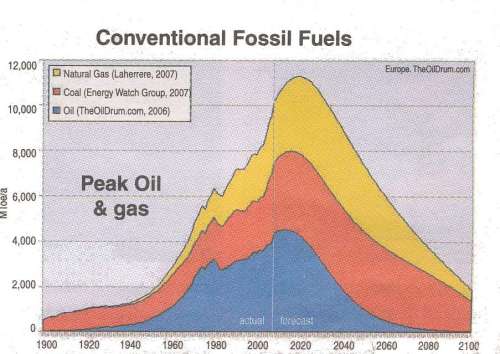Agrichemical companies argue we need their products to feed a growing population. I question this. Sure the population is growing but modern agricultural practice is very energy intensive both in production and distribution of the food. A sustainable future is going to require that food be grown close to the consumers and we are going to have to accept the return of human waste in some form, back to agricultural land. This is already being done at Kojanup as reported by Flint Duxfield on ABC Rural story Turning poo into profit . We can't continue to mine NPK and then dump the resultant human waste as a pollutant. Industrial agriculture isn't interested in growing food for people with no money so communities are going to have to learn to feed themselves.
The respected Australian Government scientific organization, CSIRO reported in ECOS magazine the issue of finite fertaliser supplies. In an article entitled Peak fertilizer, Kath Kovac wrote "The only solution seems to be to return to the old familiar concept of 'reduce, re-use, and recycle'. We need to reduce fertaliser use and nutrient loss to the environment." (Kovac, K. 2010)
Modern agricultural practice requires expensive inputs, a significant proportion of these inputs relate to fossil fuel use. As oil and gas prices increase many current practices will become uneconomic. For example according to Eddie Funderburg in the website article www.noble.org , it requires as much natural gas to manufacture 1Kg of Nitrogen fertilizer as to produce a Kg of steel. (Funderburg E, 2010) The following graph, taken from Acres Australia Issue 18/1 illustrates the situation regarding to peak oil and gas. There is debate as to exactly when the peak will occur but not as to the general shape of the graph. 
I suggest that a sustainable future will see the end of cattle feed lots which are high energy operations generating much pollution and providing a breeding ground for disease. Grass fed sheep and cattle provide a very efficient way to convert low grade herbage to high value protein. Herbivores evolved on grasses, not grains, those grown on pasture have the correct omega 3 omega 6 fatty acid balance, while grain fed stock have high omega 6 fatty acid. ( www.csuchico.edu Oct 2010 )
There is a growing interest in food sources and production methods, encouraged by people like celebrity Chef Stephanie Alexander. The Stephanie Alexander Garden Foundation CEO Ange Barry, talking about the work of foundation, was reported in Acres Australia as saying
"they felt the program would have a positive impact on the agricultural industry and undoubtedly the organic industry. Children will become consumers of the future who will look to things like Farmers Markets and are more critical of what they are buying and eating and they'll be driven by their taste buds." (Rankin R. 2010)
While this website advocates organic farming principals, buying organic isn't necessarly the most sustainable option as Tim Marshall of TM Organics is quoted as saying in Growing your own Heirlooh Vegetables by Clive Blazey.
When it comes to choosing the food I Buy, organic is actually my fourth choice. I would choose local and seasonal products, particularly from Farmers Markets ahead of organically certified products, particularly if these products have traveled long distances. I feel that our diet needs a diversity of foods, all of which I consider ahead of organically grown food (Blazey C, 2008)
A rapid increase in the use of chemical fertalisers and insecticides occuresd after WW2 as manufacturers looked for a use for new uses for the products of the factories built to produce explosives and biological agents of war. There has been an 800% increase in chemical fertalisers since 1950 for only a 53% increase in yeild, and in the USA wheat protein content has droped from 17% in 1940 to 9% today (Norrie, 2007)


